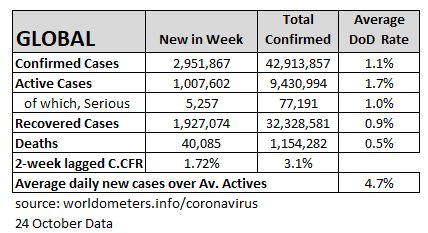
COVID-19 Monday Roundup 26 October 2020
Almost three million new cases confirmed globally in a single week as cases surge around the world. Meanwhile only 32 cases of locally acquired cases in Australia in the last week, comprising 27 in Victoria and five in NSW. The US experienced 20% more deaths than expected during March to July, with two thirds of the excess documented to be from COVID-19. If the US death rates were comparable to Australia, the US would have had 187,661 fewer COVID-19 deaths in this period. And the antiviral drug Remdesivir has been approved by US FDA for treatment of COVID-19 requiring hospitalisation despite lack of evidence supporting its effectiveness.
World Summary – 24 October

How many ways can you say ‘Ugly!’?
It took nearly five months to the end of April for COVID-19 to infect its first three million people. It took one week to 24 October for it to infect its latest three million people.
Similarly, it took until 7 April for there to be 1.0 million active cases, and this week active cases rose by 1.0 million.
Against that, although deaths rose, as a percentage of two-week lagged new cases they fell to a new low of 1.72%, the 6th week of a continuing pattern of falls.
Across the regions:
- East and West Europe and North America are all experiencing significant increases in new cases and now deaths. The USA is, once again, the world leader in cases and deaths. Germany is seeing big case increases but well below those of smaller neighbours and with significantly lower deaths, to date.
- Only Africa, Asia and Oceania appear to be in control or making progress toward control.
- The Middle East mostly saw case and death increases with Israel being a significant exception.
- Latin America was a mixed bag with progress in a number of countries but also some deteriorating.
- In Oceania, the only locality of concern at the moment is the growing outbreak in French Polynesia.
Australia Summary – 25 October
Australia recorded 129 new cases this week (127 last week), taking total case numbers to 27,518. While total case numbers were similar, Australia recorded more overseas traveller cases (97 versus 61 last week) and less locally acquired cases (32 versus 66 last week).
Overseas traveller cases were higher largely due to 24 cases in crew members from an international vessel (the Al Messilah) included in the WA total.
Locally acquired cases were again only recorded in Victoria and NSW:
- Victoria recorded 27 cases (34 last week), including 20 cases linked to the northern suburbs community cluster (total 37). Yesterday’s planned announcements on reopening were put on ‘a cautious pause’ for 24-48 hours due to this cluster. The additional time was to allow for test results for people in the northern suburbs, to provide some assurance that there is not a lot of unidentified community transmission in the area. 1,135 tests had all come back negative as at 6pm last night. Another 1,400 swabs were taken yesterday with results still pending at the time of writing.
Single cases were linked to four existing clusters. There were also two cases in people who have previously tested positive, with these being investigated to determine whether they are reinfections or shedding of old virus. One case remains under investigation.
Victoria recorded only one death (six last week).
- NSW recorded five cases (32 last week), including three linked to the Oran Park cluster (total 22) and two linked to the Liverpool private clinic (total 13).
The Victorian DHHS issued this statement acknowledging that there is the potential for aerosol transmission of COVID-19, and requiring P2/N95 respirators for healthcare workers treating COVID-19 patients in Victoria.
Key market update
Credit Ratings. Following Standard & Poor’s (S&P) reaffirming its AAA credit rating, Australia remains one of only nine countries globally to hold a AAA credit rating from all three major credit rating agencies.
Jobs & Business. Unemployment rate increased marginally to 6.9% in September (6.8% in August). Payroll jobs are still 4.1% below mid-March levels nationally (Victoria 8.0%). The number of jobless families has increased in 2020 with more than one in five families having all members (aged 15+) being unemployed, according to the ABS. Meanwhile, ABS survey results show fewer businesses reported a revenue decrease in October (31%) compared to July (47%). The Australian Business Growth Fund (BGF) has been formally established, jointly funded by the Government and major banks, it will operate commercially and make investment decisions independently of the Government.
ASIC. ASIC’s annual report includes its response to COVID-19. The expectation on general insurers with regards to handling business interruption claims brought by small businesses have been set in a letter from ASIC. Conditions have also been imposed on the issue and distribution of contracts for difference (CFD), where retail client accounts of the sampled CFD issuers made net losses of $774m over the five-week period from 16 March to 19 April, amid heightened market volatility during the pandemic.
APRA. APRA’s annual report observes the financial services industry has held up well during the pandemic, despite a number of significant challenges arising from the pandemic. The Early Release Initiative (ERI) data collection and COVID-19 Pandemic Data Collection (PDC) have been updated, with some data collection being discontinued from 30 September.
AFCA. The temporary additional nine days firms have had to respond to complaints will end on 1 November.
Business Interruption Insurance. ASIC has written to general insurers setting out its expectations on handling business interruption claims brought by small businesses. APRA’s annual report has flagged ongoing uncertainty of business interruption insurance.
Industry. Lloyd’s new report, “Building simpler insurance products to better protect customers”, says post-COVID the global insurance industry should move towards simplifying products and involve customers directly in product design.
New COVID-19 research
Fewer trauma admissions during NSW lockdowns. This pre-print paper showed that during COVID lockdowns between March and May, trauma admissions, severely injured patients, intensive care admissions and deaths at a major NSW trauma hospital were lower than previous years. There were no significant differences in mechanism of injury.
Excess Deaths. The U.S. experienced 20% more deaths than expected from March through July 2020, with two thirds of the excess documented to be from COVID-19. Excess mortality in the US is higher than 18 other OECD countries. If US death rates were comparable to Australia, the US would have had 187,661 fewer COVID-19 deaths. A separate study of 21 countries in Europe + Australia suggests excess deaths from Feb-May were as high as 37% in England and Wales and 38% in Spain, while 9 countries including Australia and New Zealand had less than a 5% increase in deaths and in some cases declines.
Infection Fatality Rates. The estimated COVID-19 infection-fatality rate in New York City between March and June was 1.4%. For adults aged 65-74 it was 4.9% and 14.2% for those aged 75+.
Trial will intentionally infect humans. In January UK scientists will launch a human challenge trial to determine the minimal amount of SARS-CoV-2 needed to cause an upper respiratory tract infection.
Rapid testing moves closer to reality. In a study supported by the Dutch government, a new technology, DETECTR, which has a turnaround time of 30 minutes, had comparable sensitivity and superior specificity to standard PCR testing. Reviews of other rapid tests show mixed results in this pre-print study.
Treatment approved despite lack of evidence. The U.S. Food and Drug Administration approved the antiviral drug Remdesivir for treatment of COVID-19 requiring hospitalisation. It is the first COVID-19 treatment to receive FDA approval, having previously received emergency use authorisation. This is despite interim evidence from the WHO’s Solidarity trial that suggest neither Remdesivir, Hydroxychloroquine, Lopinavir nor Interferon are effective in reducing mortality, ventilation and duration of hospital stay. Indeed, in what was a fairly depressing week for news on treatments, Convalescent plasma and Tocilizumab showed no clinical benefits in trials of patients hospitalized with moderate COVID-19.
Risk Factors. After adjustment for potential confounders, adults in the UK with Down syndrome had roughly five times the risk for COVID-19 hospitalisation and 10 times the risk for COVID-19 mortality.
Humans can infect our pets. Researchers have shown both cats and dogs can be infected with SARS-CoV-2, but did not develop significant clinical disease. Cats could also spread the virus to other cats.
CPD: Actuaries Institute Members can claim two CPD points for every hour of reading articles on Actuaries Digital.






